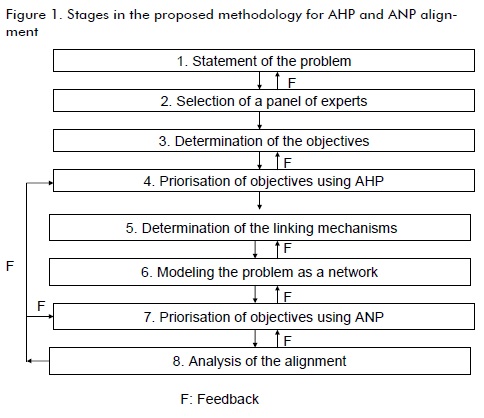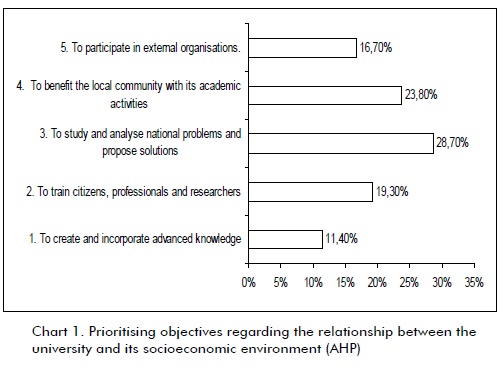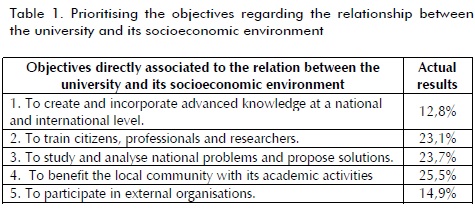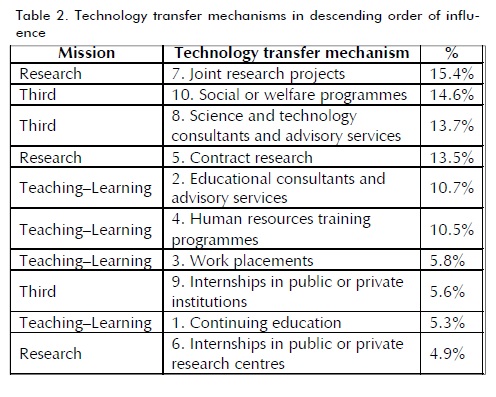Serviços Personalizados
Journal
Artigo
Indicadores
-
 Citado por SciELO
Citado por SciELO -
 Acessos
Acessos
Links relacionados
-
 Citado por Google
Citado por Google -
 Similares em
SciELO
Similares em
SciELO -
 Similares em Google
Similares em Google
Compartilhar
Ingeniería e Investigación
versão impressa ISSN 0120-5609
Ing. Investig. v.31 n.1 Bogotá jan./abr. 2011
University objectives and socioeconomic results regarding engineering: multi-criteria measuring of alignment
Félix Antonio Cortés Aldana1, Ismael Peña Reyes2, Jaime Orlando Cortés Aldana3
1 PhD in Engineering Projects and Innovation. M.Sc. in Economics. Associate Professor and Member of research group UNALGOS, Department of Systems and Industrial Engineering, Faculty of Engineering, Universidad Nacional de Colombia. facortesa@unal.edu.co.
2 PhD. in Management Information Systems. M.Sc. in Management Information Systems. MA in Education. Associate Professor, Department of Industrial and Systems Engineering, Universidad Nacional de Colombia. jipenar@unal. edu.co
3 M.Sc. in Economics, Universidad Nacional de Colombia. Government employee, Gobernación de Cundinamarca. jaime.cortes@cundinamarca.gov.co
ABSTRACT
University faculties and schools develop mechanisms for knowledge transfer as tools for achieving goals stated in a university's mission regarding its socio-economic environment. The main purpose of this paper is to present the results obtained after measuring the degree of alignment of a university's strategic objectives with results obtained by a faculty through its knowledge transfer mechanisms. This allows for diagnosis by comparing the situation desired by the university management team (expected case) with actual results achieved by developing plans applying the knowledge transfer mechanisms (real case). Multicriteria decision analysis techniques (MCDA) were thus applied, namely analytic network process (ANP) and analytic hierarchy process (AHP). The results relied on the experience and perceptions of the experts who participated in the study. The methodology proposed in this paper has been applied in the Universidad Nacional de Colombia's Faculty of Engineering. The study led to measuring the importance of each of a university's strategic objectives, the results achieved in a faculty regarding each objective, the degree of alignment between expected and actual results and each knowledge transfer mechanism's level of influence.
Keywords: relationship between university and socioeconomic environment, multiple criteria analysis, analytic network process (ANP), analytic hierarchy process (AHP).
Received: October 16th 2009. Accepted: Feuary 20th 2011
Introduction
Universities have always been social institutions so they have maintained a relationship with their socio-economic development through their schools or faculties from their early moments in the twelfth century. Their missions and purposes have also been guided by the specific circumstances of the socioeconomic and political environment in which they occur (Geuna and Nesta, 2006). The relationship between universities and socio-economic environment involves a set of processes and practices constituting knowledge transfer mechanisms4 where university academic and administrative elements are interrelated and connected with the outside world to develop and implement action and projects for the benefit of all (Cortes-Aldana et al., 2009). Knowledge transfer mechanisms are instrumental means for facilitating the establishment of the interaction between universities and their socio-economic environment. The mechanisms for transferring recent knowledge include spin-offs or joint businesses, business incubators and science or technology parks. These are aimed at complementing and strengthening traditional mechanisms such as training human resources, industrial training units, academic consultancy, scientific and technological services, recruiting future professionals, specific or sets of contract research and technological innovation projects, use of university facilities, licensing and exploiting inventions (Bramwell and Wolfe, 2008; D'Este and Patel, 2007; Lee and Win, 2004).
This paper takes transfer agents characteristics into account, such as a university's faculties or schools, and the means of transfer, such as knowledge transfer mechanisms (Bozeman, 2000). Its object was to assess the degree of alignment between a university's goals or strategic objectives and the results obtained from applying knowledge transfer mechanisms in a faculty. The unit of analysis was one of the largest faculties at the Universidad Nacional de Colombia (www.unal.edu.co): the Faculty of Engineering in Bogotá (http://www.ing.unal.edu.co/). The Universidad Nacional de Colombia is an autonomous academic body attached to the Ministry of National Education, having a special scheme, being defined as a national, public and state university. Its objective is developing higher education and research which will be supported by the state allowing access to it and fostering its development, at the same time as science and arts, to achieve excellence. It has a pluralistic, multi-class and secular nature as a public institution. The university does not respond to particular interests, allowing thinking and proposing solutions for national problems over concerns related to economic profitability. The Universidad Nacional de Colombia has seven facilities distributed throughout Colombia (Bogotá, Medellín, Manizales, Palmira, Leticia, Arauca and San Andres); despite this, it is seen as just one national campus, a centre where different and often contradictory currents of thought and urban expressions are found, emphasising its ability to represent the Colombian nation.
This evaluation compares the situation desired by the university’s board with the real situation, resulting from implementing plans for developing knowledge transfer mechanisms associated with the university's three missions and in relation to the socioeconomic environment. Analysis was based on multi-criteria decision analysis techniques (MCDA), analytic network process (ANP) (Saaty, 1996) and the analytic hierarchy process (AHP) (Saaty, 1980).
Methodology and data
The proposed methodology took the characteristics of the alignment problem to be analysed into account (Cortes et al., 2009), the general decision-making stages (Aragonés et al., 2008) and specific multi-criteria decision analysis (MCDA) techniques AHP and ANP (Saaty, 1980) (Saaty, 2001), which followed the steps shown in Figure 1.

MCDA is a, "term that includes a set of concepts, methods and techniques that aim to help individuals or groups to make decisions, which involve various conflicting views and multiple stakeholders" (Belton and Stewart, 2002). All these MCDA concepts and methods have been extensively studied in operations research literature (Barba-Romero and Pomerol, 1997, Belton and Stewart, 2002, Figueira et al., 2005). Selecting the appropriate MCDA technique is not easy. According to (Bouyssou et al., 2000), several models can be used in decision-making; there is no best model. AHP (Saaty, 1980) and ANP (Saaty, 2001) are used in this paper for greater recognition in MCDA; combining them allowed each of them to be used during the modelling stages, thereby presenting the greatest advantages.
The AHP technique has been used in this work to assign priorities to the university's objectives regarding its surroundings. This technique models a decision-making problem as a hierarchy of levels which are uni-directionally related to each other. The upper level of the hierarchy is the problem's objective; the lower level consists of alternatives to be evaluated and intermediate levels are tangible criteria and/or tangibles contributing to the problem and are based on which alternatives are being evaluated. AHP assigns weighting to each level's elements to measure their local importance and ultimately determines the overall weighting of alternatives through an additional process by paired comparison, using the fundamental Saaty scale. Judgment consistency is measured by a consistency ratio which must be equal to or less than 0.10 to be accepted. AHP's mathematical basis can be found in (Saaty, 1994) (Saaty, 1996). While AHP is conceptually easy to use, its strict hierarchical structure cannot address many real problems' complexity. Saaty thus proposed the ANP, a generalisation of the AHP, through which a network model of a university's missions could be represented: teaching, research and third mission, knowledge transfer mechanisms and interactions. ANP represents a decision-making problem as a network of criteria and alternatives (all coming ubder under the term "elements"), grouped into components. All network elements can incorporate feedback and interdependent relationships between components, allowing for more accurate modelling of complex scenarios. Network element influence on other elements in the model is recorded in a supermatrix; this is a square matrix whose dimension is the number of network elements. The supermatrix stores the relative weighting for the elements’ influences from the rows on the column, obtained by paired comparison.
This technique was used in this work for the following reasons: prioritising objectives is a multi-criteria decision problem, some objectives to be prioritised are intangible and therefore, it is difficult to establish their importance using other methods and there may be interdependence among a university's missions and between such missions and mechanisms.
ANP has been used recently in different decision-making problems, such as valuation of urban industrial land (Aragones et al., 2008), selecting strategies (Yüksel and Dagdeviren, 2007), selecting management for a company's supply chain (Agarwal et al., 2006), determining a country's best energy policy (Haktanırlar, 2005), selecting the best reverse logistics option in computers (Ravi et al., 2005) and joint planning of products (Chung et al., 2005). ANP applications for analysing a university's goals or purposes regarding faculty results in relation to socio-economic development have not yet appeared.
The information needed for using these techniques was gathered through surveys aimed at experts in the field. The methodology’s models were defined by taking different approaches into account which have been recognised as being important elements in the pertinent literature, especially considering the works mentioned in the introduction about the relationship between university and socioeconomic environment. The methodology was applied to the Universidad Nacional de Colombia in BogotÁ (UNC-BogotÁ), one of the most important Colombian universities, following the steps shown in Figure 1.
Results and Discussion
A questionnaire was designed (see Annex 1) for prioritising the goals (stage 4) and distributed among a first group of experts (university leaders) selected for the study.
The questionnaire led to the experts prioritising the objectives set by using paired comparison of purposes and the scale proposed by Saaty. The experts took one week to answer the questionnaire and showed great interest in knowing the methodology in greater depth and in being informed about the results of its application. The experts were questioned again if surveys exceeded 10% inconsistency. It was decided to continue the process as long as inconsistency remained by adding experts' ratings until achieving less than or equal to 10% inconsistency, taking into account the results of (Xu, 2000) and (Escobar et al., 2004).
ExpertChoice 2000 software was used for calculating AHP. The responses from individual questionnaires were introduced and integrated to obtain a priority group for university purposes.
The results of such prioritisation for all experts were as follows:

The above data shows that all purposes were not equally important. Some were more important than others (according to expert opinion). Purposes 2, 3 and 4 constituted over 70% of allocation of effort. UNC-Bogotá should therefore be largely orientated towards achieving these three goals.
Once the level of importance had been quantified for each end through several sessions with a second group of experts (Engineering faculty managers and teachers) and taking into account the university's extension programme regulations (Agreement 11, 2005), the transfer mechanisms identified ten critical areas of knowledge to consider in the relationship be tween the university and its socio-economic environment (stage 5). The knowledge transfer mechanisms identified within each UNC-BOGOTA mission was classify with the experts (stage 6). Figure 2 represents the problem through a network.
The network model (ANP) was evaluated by the second group of experts (Engineering faculty managers and professors) selected in step 7. Four questionnaires were designed for the case study and then handed out; each questionnaire contained 228 questions (see Annex 2).
Each expert, according to their degree of experience and knowledge, answered questions related to some of the following: a) influences between knowledge transfer mechanisms associated with the teaching-learning and purposes, b) influences between knowledge transfer mechanisms related to research and purposes, c) influences between knowledge transfer mechanisms associated with the third mission and purposes, d) influences between knowledge transfer mechanisms associated with each mission (teaching and research and third mission). The above aspects form part of the influence model proposed for this study (Figure 2).
The value for surveys exceeding 10% inconsistency was reduced by asking the experts to confirm their answers. Given this situation, similar to AHP, it was decided to continue as long as inconsistency obtained by adding the ratings of the various experts was less than or equal to 10%.
The consensus values were entered into a program implementing the ANP method: SuperDecisions. The program computed the following matrices: original supermatrix, weighted supermatrix, limit supermatrix. The objectives were prioritised based on the supermatrix limit (see Annex 3):

In stage 4 of the methodology, theoretical prioritisation purposes were obtained. The following graph was obtained when these were compared to the purpose satisfied in the knowledge transfer mechanisms according to stage 7:
Chart 2
The previous graph analysis (step 8) focused on reviewing compliance with expected results and identifying the main differences between expected and achieved results for each purpose.
It can thus be seen that purposes 1, 2, 4 and 5 were fulfilled in some way with university managers' expectations but in 3 of the 4 purposes the level of achievement surpassed expected results by several percentage points or pp (purpose 5 by 5.9 pp, purpose 4 by 4.6 pp, purpose 2 by 4pp, and purpose 1 by 1.5 pp). The greatest difference between expected and achieved results is shown concerning purpose 3, "studying and analysing national problems and proposing solutions," representing an achievement level well below university mangers' expected results (16 pp). The major differences between expected and achieved results occurred in purpose 3, 5, 4 and 2.
Given the above, an alignment between expected and achieved could only be seen for purpose 1, "creating and assimilating advanced knowledge at national and international level." It was concluded that there was strong misalignment between expected and actual purposes, since only one out of five lined up. Such misalignment was mainly due to the transition that the university’s faculties are going through. New initiatives from a government team aim to strengthen and complement the university’s social mission or "university extension", encouraging a more direct contribution to economic development through knowledge transfer mechanisms. The influence of knowledge transfer mechanisms associated with each mission can be seen in the following table:
The above table shows that the major influences came from knowledge transfer mechanisms compared to research (28.9%, 7 and 5), third mission (28.3%, 8 and 10) and education and teaching (21.2%, 2 and 4). University practice (3, 9 and 6) had lower levels of influence in each area. Continuing education (1) had little influence on the education-teaching field.

These results are of importance in defining future policies and strategies for strengthening transfer knowledge mechanism by the government team at the Universidad Nacional de Colombia.
Conclusions
This article has shown how to address complex problems such as measuring the alignment of a university's strategic objectives with results achieved by knowledge transfer mechanisms and their socio-economic development in a faculty or school.
Multi-criteria decision analysis-based methodologies were used for such measurement. It became clear while working with the experts that designing a hierarchical structure (AHP) and a network (ANP) structure requires experience and knowledge of the problem in question, pertinent information being essential for suitable problem analysis.
Using analytic hierarchy process (AHP) led to prioritising the university's purposes and verifying that not all purposes were equally important. Network analysis process (NAP) enabled them to be prioritised based on actual results achieved for university purposes by applying knowledge transfer mechanisms. Misalignment was detected when comparing the first priority with the second, proving that differences were significant for "studying and analysing national problems and proposing solutions," "participating in external organisations," "benefiting the academic productivity environment," and "educating citizens, professionals and researchers." This should lead to the university and the Engineering faculty implementing corrective policies for achieving the purposes set out in theory.
The results obtained are useful for decision-making in university policies related to strategies concerning knowledge transfer between universities and their environment, as well as for quantifying features of the university passing through a transition period in which the relevance of each activity associated with the interaction between the university and its socio-economic environment is sought.
The challenge facing the university and its faculties is to make a greater and better contribution towards social and economic development through knowledge transfer mechanisms identified in the methodology presented here.
ANNEX 1: Part of the questionnaire for establishing weighting between objectives using AHP
For each pair of objectives, highlight in black which of the two you consider more important and by how much. Each pair of purposes should be compared by asking to what degree objective Oi is better than Oj using the following scale (Saaty scale):
Cij = 1: you consider purpose i and purpose j equally important
Cij = 3: objective i is considered slightly more important than objective j
Cij = 5: objective i is considered significantly more important than objective j
Cij = 7: objective i is considered much more important than objective j
c ij = 9: objective I is considered absolutely more important than objective j
-----------------------------------------------------
O1: creating and assimilating advanced knowledge at national and international levels
O2: educating citizens, professionals and researchers

Annex 2: Part of the ANP questionnaire for measuring influence
Regarding, "Educating citizens, professionals and researchers," for each pair of knowledge transfer mechanisms, highlight in black which one you think is more influential and how much.
Each pair of knowledge transfer mechanisms should be compared, asking to what degree knowledge transfer mechanism Mi is better than Mj using the following scale (Saaty scale)
Cij = 1: you consider mechanism i and j equally influential
Cij = 3: mechanism i is considered slightly more influential than mechanism j
Cij = 5: mechanism i is considerably more influential than mechanism j
Cij = 7: mechanism i is considered more influential than mechanism j
Cij = 9: mechanism i is absolutely more influential than mechanism j
-----------------------------------------------------------------------
M1: Continuing education
M2: Academic services

ANNEX 3: Supermatriz límite
ANNEX 3
Foot Notes
4 The term "knowledge transfer" is used in this paper considering that Meyer-Krahmer and Schmoch (1998) found that the alternative term "exchange of scientific knowledge" was the central element of university-industry relationship and university-socio-economic environment relationship.
References
Agarwal, A., Shankar, R., Tiwari, M. K., Modeling the metrics of lean, agile and leagile supply chain: An ANP-based approach., European Journal of Operational Research,173 (1), 2006, pp. 211-225. [ Links ]
Aragonés-Beltrán, P., Aznar, J., Ferrís-Oñate, J., García-Melón, M., Valuation of urban industrial land: An analytic network process approach., European Journal of Operational Research, 185, 2008, pp. 322-339. [ Links ]
Barba-Romero, S., Pomerol, J.C., Decisiones Multicriterio., Fundamentos Teóricos y Utilización Práctica., (1 ed.) Servicios de Publicaciones Universidad de Alcalá, 1997. [ Links ]
Belton V., Stewart T.J., Multi Criteria Decision Analysis: an integrated approach., Kluwer Academic Publishers, Boston, 2002. [ Links ]
Bouyssou, D., Marchant, T., Pirlot, M., Perny, P., Tsoukias, A., Vincke, P., Evaluation and Decision Models: A Critical Perspective., Kluwer Academic Publishers, Boston, 2000. [ Links ]
Bozeman, B., Technology transfer and public policy: a review of research and theory., Research Policy 29, 2000, pp. 627-655. [ Links ]
Bramwell, A., Wolfe, D. A., Universities and regional economic development: The entrepreneurial University of Waterloo., Research Policy 37, 2008, pp. 1175-1187. [ Links ]
Chung, S., Lee, A.H.I., Pearn, W.L., Analytic network process (ANP) approach for product mix planning in semiconductor Fabricator International., Journal of Production Economics 96, 2005, pp. 15-36. [ Links ]
Cortés-Aldana, F.A., García-Melón, M., Fernández-de-Lucio, I., Aragonés-Beltrán, P., Poveda-Bautista, R., University objectives and socioeconomic results: A multicriteria measuring of alignment., European Journal of Operational Research, 199, 2009, pp. 811-812. [ Links ]
D´Este, P.,Patel P., University-industry linkages in the UK: What are the factors underlying the variety of interactions with industry?, 36, 2007, pp.1295-1313. [ Links ]
Escobar, M.T., Aguarón, J., Moreno-Jiménez J.M.; A note on AHP group consistency for the row geometric mean priorization procedure., European Journal of Operational Research 153, 2004, pp. 318-322. [ Links ]
Figueira J., Greco S., Ehrgott M., Multiple criteria decision analysis: state of the art surveys., Springer, New York, 2005. [ Links ]
Geuna, A., Nesta L., University patenting and its effects on academic research: The emerging European evidence., Research Policy 35, 2006, pp. 790-807. [ Links ]
Haktanirlar, B., Determination of the appropriate energy policy for Turkey, Energy 30, 2005, pp. 1146-1161. [ Links ]
Lee, J., Win, H.N., Technology transfer between university research centers and industry in Singapore., Technovation 24, 2004, pp.433-442. [ Links ]
Meyer-Krahmer, F., Schmoch, U., Science-based Technologies: university-industry interactions in four fields., Research Policy 27, 1998, pp. 835-851. [ Links ]
Ravi, V., Shankar, R., Tiwari, M. K., Analyzing alternatives in reverse logistics for end-of-life computers: ANP and balanced scorecard approach., Computers & Industrial Engineering 48, 2005, pp. 327-356. [ Links ]
Saaty, T.L., The Analytic Hierarchy Process., McGraw-Hill, New York, NY, 1980. [ Links ]
Saaty T.L., Fundamentals of decision making and priority theory with the AHP., RWS Publications, Pittsburg, 1994. [ Links ]
Saaty, T.L., Toma de decisiones para líderes; Pittsburgh: University of Pittsburg, 1996. [ Links ]
Saaty, T.L., The Analytic Network Process; Decision Making with Dependence and Feedback (2 ed.), Pittsburg: RWS Publications, 2001. [ Links ]
Xu, Z., On consistency of the weighted geometric mean complex judgement matrix in AHP., European Journal of Operational Research 126, 2000, pp. 683-687. [ Links ]
Yüksel, I., Dagdeviren, M., Using the analytic network process (ANP) in a SWOT analysis - A case study for a textile firm., Information Sciences, 177, 2007, pp. 3364-3382. [ Links ]











 texto em
texto em 


